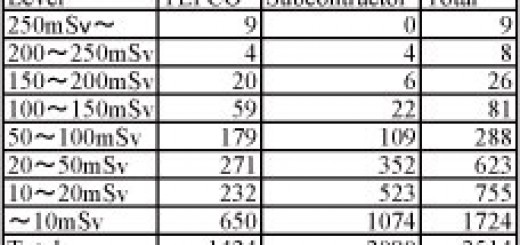Worker Radiation Exposure at Rokkasho Reprocessing Plant Nuke Info Tokyo No. 131
Active testing of the Rokkasho Reprocessing Plant is on hold due to repeated problems with the vitrification facility. Completion of the tests was rescheduled for August this year, but that target is clearly unachievable. With Japan Nuclear Fuel Ltd. (JNFL) in no position to say when the tests will be completed, the future of the plant is becoming less and less clear and the electric power companies’ plutonium utilization plans are falling further and further behind.
 |
Cartoonby
Shoji Takagi |
In January this year an accident occurred in which about 150 liters of high-level radioactive liquid waste leaked within a cell of the vitrification building (NIT 129, 130). Operations stopped completely and many other problems arose as a result of equipment that was corroded by evaporated liquid waste which contained nitric acid. For example, the cogs of a crane used to clean the cell would not work because of corrosion.
On June 6 a worker, who was in his thirties, was exposed to radiation while working to restore the vitrification facility. He was exposed to radiation when he entered the repair room within the cell to replace parts on a remotely controlled manipulator which was not working properly. While replacing the parts he put his left knee on a trolley that carried the manipulator. The measurement taken as he left the radiation control area showed a reading for cesium of 6 becquerel and a radiation dose of 0.4 milli-sieverts. According to JNFL, the cause of the radiation exposure was that the paper protective clothing and cloth work clothes that he was wearing became wet from his perspiration. This allowed the evaporated radioactive waste liquid to permeate through his clothing. JNFL said that in future it would require workers to wear clothes with impermeable knee patches and the like.
Large quantities of nitric acid and highly volatile radioactive iodine have evaporated and dispersed within the cell, so it is highly likely that numerous problems will continue to arise in equipment and machinery and that workers will be forced to carry out further work within the cell. There is, therefore, reason to be concerned that more radiation exposure incidents will occur and that the doses incurred by workers will increase. These workers are not JNFL’s own employees. They are employed by subcontractors.
On June 19, there was another case of worker radiation exposure, this time while carrying out work on the spent fuel storage pool. A man in his forties was inspecting the spent fuel pool crane. The radiation check after he took off his work clothes showed a reading for cobalt of about 5 becquerel on the big toe of his right foot. The radiation dose was calculated to be 0.3 milli-sieverts.
JNFL claimed that, since he was not directly involved in the work, it was highly likely that he stepped on the material in the change room with his bare foot. In other words, radioactivity that was on another worker’s clothes fell to the floor in the change room. That means that this radioactivity was not detected by the radiation check before he entered the change room. It also suggests that radioactivity is scattered all over the place throughout the plant. Indeed, a similar incident occurred in August 2007.
These radiation exposure incidents clearly demonstrate the inadequacy of JNFL’s radiation control system.
Masako Sawai (CNIC)

